|
Notes: Stanley station was situated on the London & North Western Railway (LNWR) Canada Dock branch which ran from Edge Hill to Canada Dock. The line was authorised in 1861 and its primary purpose was to give the LNWR access to the most northerly of the Liverpool Docks. The LNWR had goods stations at Wapping Dock (opened October 1830) and at Waterloo (opened 1 August 1849) but since these stations had opened the docks had continued to spread northwards. The Canada Dock branch did not take a direct course from Edge Hill to Canada owing to the topography of the area. It ran in a north/south direction through Tue Brook at a distance of about two miles from the river front. Only when it reached Anfield (north of Tue Brook) did it start to turn towards the west and head down to the docks.
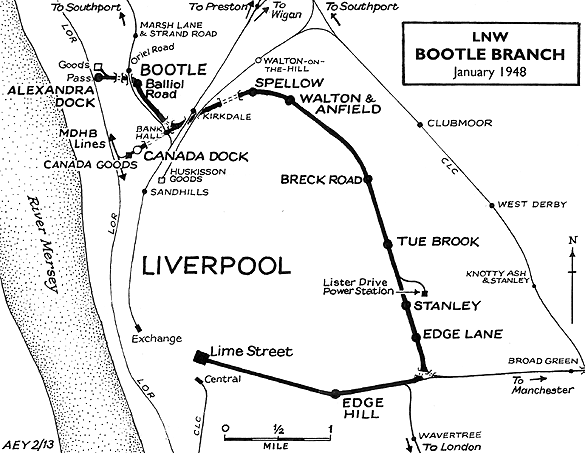 |
The double-track line opened in two stages, the first being from Edge Hill to Tue Brook on 1 June 1866. Stanley station opened with the first section of the branch. It was located in a cutting on the north side of Prescot Road.
The building at street level straddled the line. It was a brick structure of restrained elegance, single-storey and under a hipped slate roof generous both in height and width. The frontage was strangely asymmetrical; the almost-central doorway was placed within a pointed arch, and two pairs of round-headed window openings were placed either side of the doorway with a further single round-headed window opening at the east end. Bricks of alternating colour added decoration to the window heads. On the rear of the building, overlooking the platforms, the window arrangement and decoration were repeated, with an extra paired round-headed window corresponding to the position of the doorway on the frontage;
There were internal steps on both sides of the line that led down to doorways located under the booking office. External steps connected the doorways to the platforms.
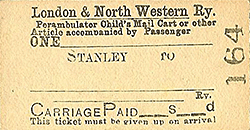 Goods facilities were provided to the north of the station on the east side of the line. They consisted of two sidings, a weighing machine and a 3-ton lifting crane. At the time of opening passenger services ran between Liverpool Lime Street and Tue Brook. Goods facilities were provided to the north of the station on the east side of the line. They consisted of two sidings, a weighing machine and a 3-ton lifting crane. At the time of opening passenger services ran between Liverpool Lime Street and Tue Brook.
On 15 October 1866 the line was opened from Tue Brook to Canada Dock but only for goods services. The passenger service continued to run only between Lime Street and Tue Brook until 1 July 1870 when a passenger station opened at Canada Dock. For the opening to Canada Dock intermediate stations were also provided at Edge Lane, Breck Road and at Walton.
In 1867 a short branch 28 chains in length was authorised from the Bootle branch to a livestock market that had opened in 1830. The branch diverged from the main line 19 chains to the north of the station at what became Stanley Cattle Junction. The market branch was provided with its own goods station called Stanley Cattle (click here to read more about the station and branch). An LNWR minute proposed that the station would be opened on 11 April 1867 and there is no evidence to suggest that it did not. A signal box had been provided to control the junction by 1871; it was located on the west side of the line just north of the junction.
By 1877 levers had been installed on the up platform to control a home and a distant signal on each line. The signals were operated by station staff and they protected standing trains. The signals were cleared as soon as a train departed.
In 1877 a horse tramway was opened along Prescot Road. It connected the city centre to Old Swan and competed with the railway for passengers. At Stanley the tramway followed the course of the short-lived Liverpool &Old Swan Tramway which had been the city’s first, opening on 2 July 1861; it had closed in May 1862.
On 5 September 1881 a line was opened from Atlantic Dock Junction (just east of Canada Dock) and Alexandra Dock. Passenger trains ran along the new line between Alexandra Dock and Liverpool Lime Street. Down services from Stanley alternated equally between Canada Dock and Alexandra Dock.
On 16 May 1888 it was ordered that a separate lever frame be placed on the down platform at Stanley. The purpose of the additional lever frame enabled each line to be controlled separately.
The December 1895 timetable showed 30 up and 31 down trains on weekdays. For much of the day Stanley had a half-hourly service. All of the up services ran to Liverpool Lime Street and the down services were still split roughly equally between the two northern termini.
On 5 August 1900 electric trams were introduced onto the tramway. A frequent service linked Stanley to the city centre via a much more direct route and they competed more effectively than the horse trams for passengers. The competition resulted in a reduced passenger train service.
In 1903 a new signal box was provided at the Stanley Cattle junction. At this time a power station was under construction at Lister Drive (east of the junction). The new box was an LNWR Type 4 structure and it was fitted with a 48-lever frame (with 34 working levers and 14 spaces). The box was given the name Stanley Station. The power station opened in 1904.
The Railway Clearing House 1904 Handbook of Stations listed Stanley as being able to handle general goods, parcels, livestock and horses.
The Canada Dock branch was a very busy freight railway and during the Great War. It handled huge volumes of war-related traffic as Liverpool had become the major west-facing port.
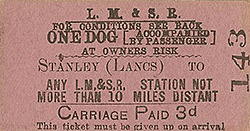 By July 1922 the passenger service had been reduced to 18 up and 19 down services. The down service pattern had also altered, there being only five services to Canada Dock but 14 to Alexandra. By July 1922 the passenger service had been reduced to 18 up and 19 down services. The down service pattern had also altered, there being only five services to Canada Dock but 14 to Alexandra.
On 1 January 1923 Stanley became part of the London Midland & Scottish Railway (LMS). The platform levers at Stanley were abolished on 25 June 1923.
Between 1924 and 1926 the Lister Drive Power Station was enlarged.
The LMS summer timetable for 1932 showed five trains from Stanley to Canada Dock, 12 trains to Alexandra Dock and 17 to Liverpool Lime Street on weekdays only.
The outbreak of the Second World War on 3 September 1939 meant that once again the Canada Dock branch had a key role to play. However Liverpool found itself in the direct line of fire and suffered heavy bombing from December 1940. On 4 May 1941 the station at Canada Dock was very badly damaged. The goods warehouse was completely destroyed by fire and the passenger station was flooded as the Leeds & Liverpool Canal had been breached by a bomb. Passenger services to Canada Dock were suspended and they were never reintroduced. Stanley was left with the Liverpool Lime Street – Alexandra Dock service.
The summer 1947 timetable showed a much reduced service of only five trains to Alexandra Dock, one to Spellow and six to Liverpool Lime Street on Monday-to-Friday only.
On 1 January 1948 Stanley became part of British Railways [London Midland Region]. As a passenger station it did not survive long after Nationalisation, closing on 31 May 1948. A passenger service between Liverpool Lime Street and Spellow (the last station before Atlantic Dock Junction, opened in September 1882) was shown in the Summer 1949 timetable with only one train in each direction. It is not known if the service actually ran and, if it did, it did not serve Stanley.
After closure the station building was used as commercial premises and it survived until the mid 1980s. The platforms had been demolished by the mid-1960s.
Passenger services continued to pass through Stanley after the withdrawal of the local service in the form of through coaches between Southport and Edge Hill. The coaches were attached to/detached from Liverpool – London Euston services. In the second half of the 1960s the through coaches were replaced by DMUs which ran until 9 October 1977.
Goods traffic to Stanley Cattle had ceased by 1971 and had ended completely by 10 June 1973 when Stanley Station signal box was closed.
In 2017 there was no trace of the station but the line remained busy with freight trains.
Tickets from Michael Stewart, timetable from Paul Wright and route map by Alan Young
Sources:
To see the other stations on the Canada Dock branch click on the station name: Canada Dock, Spellow, Walton & Anfield, Breck Road,
Tue Brook & Edge Lane
See also Alexandra Dock branch stations:
Bootle Balliol Road and Alexandra Dock (LNWR)
See also: Stanley Cattle and Stanley Junction
|

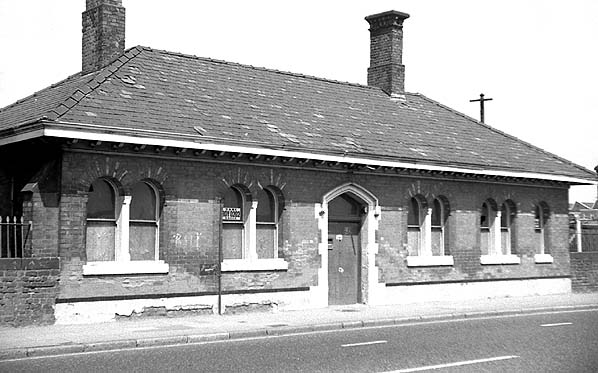
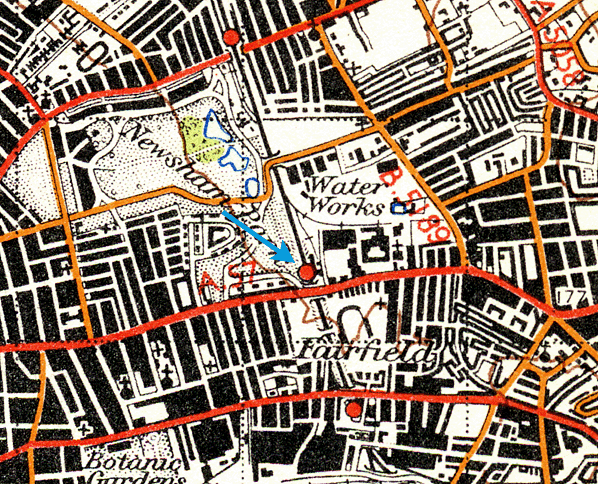
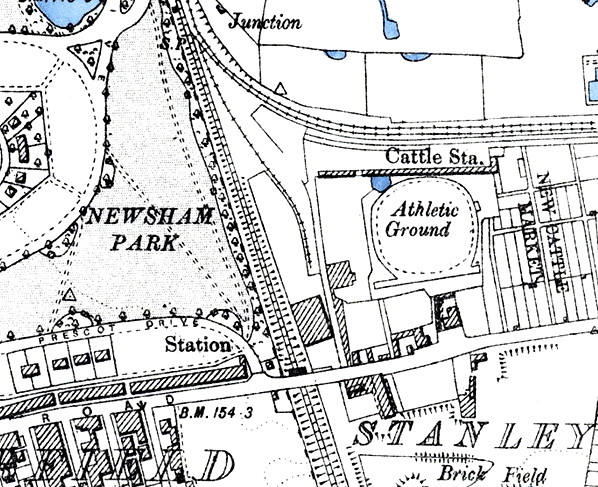

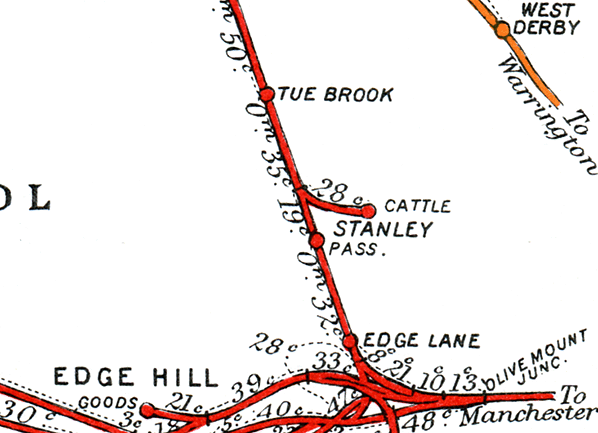

.1962.jpg)
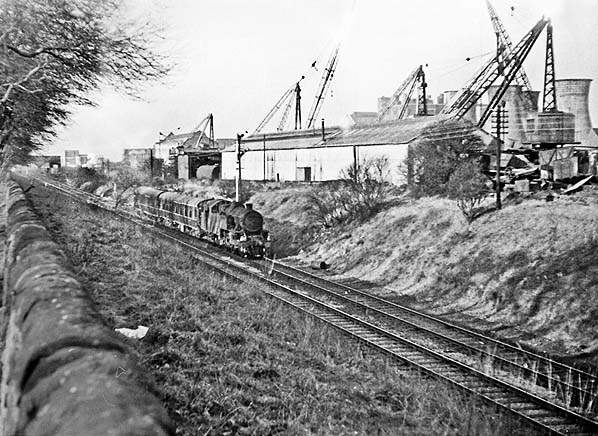
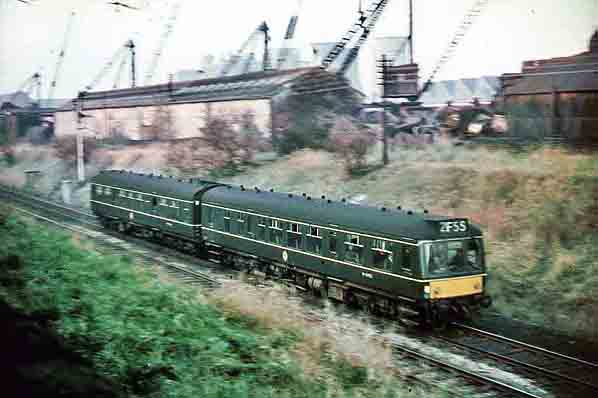 A Southport Chapel Street to Liverpool Lime Street passenger service is seen passing through Stanley station in the 1960s.
A Southport Chapel Street to Liverpool Lime Street passenger service is seen passing through Stanley station in the 1960s. Home Page
Home Page 
 Goods facilities were provided to the north of the station on the east side of the line. They consisted of two sidings, a weighing machine and a 3-ton lifting crane. At the time of opening passenger services ran between Liverpool Lime Street and Tue Brook.
Goods facilities were provided to the north of the station on the east side of the line. They consisted of two sidings, a weighing machine and a 3-ton lifting crane. At the time of opening passenger services ran between Liverpool Lime Street and Tue Brook.  By July 1922 the passenger service had been reduced to 18 up and 19 down services. The down service pattern had also altered, there being only five services to Canada Dock but 14 to Alexandra.
By July 1922 the passenger service had been reduced to 18 up and 19 down services. The down service pattern had also altered, there being only five services to Canada Dock but 14 to Alexandra. 
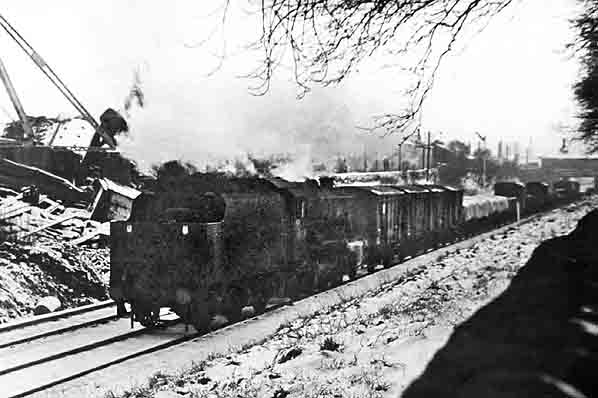

.jpg)

